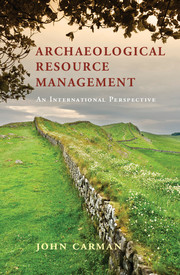2 - The development of current structures
from Part I - History and Principles
Published online by Cambridge University Press: 05 September 2015
Summary
It is clear from Chapter 1 that archaeological resource management does not cover all activities anywhere at any time related to the retrieval, collection, storage and presentation of material from the past. Instead, these activities – however similar in form to those of modern archaeological resource managers – must be understood and appreciated in their own ideological, social, political and economic context. It will also be evident from that chapter that systems of law and regulation are considered central to any system of ARM and that, indeed, they underpin and in many ways can be considered to define the parameters for any ARM system. However, there is more to ARM than a system of laws, as any practitioner can tell you: as a former employer put it to me once, ‘There is the law, and then there is the lore.’ This chapter will therefore outline how the key elements of ARM have come together in recent years by focusing on three of the areas of practice central to most modern systems of ARM.
The first of these is the rise of professionalism in archaeology. This in turn relates to the role of archaeologists in dealing with threats to the archaeological resource from more invasive systems of land use, such as industrial development, housing provision for larger and more diverse populations, intensive agriculture and the like. The first section will chart the change from ‘reactive’ systems of rescue and salvage archaeology to more proactive systems. It will also compare developments in anglophone territories with those elsewhere, where the consequences of the ideological differences seen in legal regimes outlined in the next chapter will become evident. A consequence of increasing professionalisation is a concomitant diversity in archaeological specialisms. This is evident in academic archaeology as the differences between ‘cultural’ archaeologists and archaeological scientists of various kinds (palaeoethnobotanists, archaeozoologists, geoarchaeologists, etc.). It can also be seen in the realm of ARM at the ‘gross scale’ as a perceived division between ‘academics’ based primarily in universities and ‘field archaeologists’ who ply their trade at the service of others, either as agents of government or as private contractors. More particularly in ARM it can be seen in the divisions recognised in the UK between ‘contractors’, ‘consultants’ and ‘curators’ (Schofield et al. 2011, 100–5) – all of whom are largely concerned with mitigating the effects of activities on the archaeological resource – and further in the separation from all of these of ‘public’ or ‘community’ archaeologists, known by various names, whose primary interest is in engaging with the wider community they serve (Dalglish 2013; Skeates et al. 2012; Waterton and Watson 2011). These in turn reflect the wider division between ‘mainstream’ archaeology – concerned with research into the past as a worthwhile endeavour in its own right – and ARM, where decisions about those remains are made. Some of the implications of this divide will also be evident.
- Type
- Chapter
- Information
- Archaeological Resource ManagementAn International Perspective, pp. 28 - 51Publisher: Cambridge University PressPrint publication year: 2015

